Archive for the ‘Work in progress’ Category

Photo from July 2011
I’ve just had a slender epiphany. For my Patreon yesterday I wrote a post about small projects—how many I have underway, and how satisfying it is to complete them—when it struck me that as a writer and an artist, nearly all the projects I care deeply about and think of as my Real Work are huge in scope.
I write novels, which can take years. Especially historical novels, with their months and months of research.
I have two separate, original, multi-piece embroidery projects underway, and if I thought novels were a slow-burning endeavor, boy howdy. I write at light-speed compared to the rate at which a stitching project develops from a glimmer of an idea to a transferable design to a finished piece hung on the wall. With embroidery, each ‘draft’ on the way to a final piece can take months. Even if, say, there’s a global pandemic keeping me housebound for a year, creating gaps of time where wandering around the science museum or meeting a friend for lunch used to live, my hands and eyes can handle only so much stitching and staring in a given day. And attempting something grand means lots and lots of iterations, lots of experimentation, lots of snipping away errant stitches so you can try something else.
And then of course there’s my epic, my life’s work—the homeschooling project, now in its 26th year, if you begin the count from the spring of 1995, when I began the read-and-research jag that has never stopped.
Pondering this, these large-scale endeavors I’m drawn to, in the context of my being a person who relishes the sudden, the new, the different, the spontaneous, the immediate—I have to laugh. We all live in various states of tension, tugged at by opposing forces (for example, you long to travel but don’t have the funds; or you’re happiest when you’re running but your knees are giving you hell); so the contrast between my nature and my aspirations isn’t unique, but it’s amusing.
Perhaps that’s why I took so readily to blogging and its later incarnations (most social media platforms are vehicles for microblogging, with twists): their quick turnaround, their perpetually changing nature. These forms of expression allow me to share ideas and experiences quickly, and to engage in immediate discourse about any topic that has seized my interest, right away, while the flame is burning high.
Meanwhile, the slow-burning project is simmering away, satisfying a whole different part of me. And it’s the determined part, the part with vision, the molten core roiling deep under the surface.
I grow sunflowers, and I grow trees.
As I said at the start of this post, it’s a slender epiphany—a morsel of self-understanding, not a revelation that changes the course of a river. But it’s a nourishing morsel, a crumb of lembas, that offers sustenance to both my practice of blogging and my larger-scale projects.
The splendid truth (to use Gretchen Rubin’s splendid term), of course, is that sometimes you discover that one of your sunflowers has grown into a towering oak. And some of your trees turn out to be bonsai. Either way, the point is to grow something.

Photo from August 2017. Not an oak.
Through this lens, I can survey my cluttered studio, my open tabs, my Scrivener files, my baskets and bins, and see the garden for what it is: abundance. Life. I grow milkweed, and I grow blueberries, and I grow river birches. (I also, let’s face it, grow a fair share of Bermuda grass.)
What are your flowers? What are your forests?
So, funny story. A few weeks ago my friend Sarah Tomp, whose upcoming YA novel My Best Everything I can’t wait to read, wrote to ask if she could tag me in the Writing Process Blog Tour. It sounded fun, but I was feeling pretty swamped that week, so I thanked her and declined. A day or two later, another local writer friend, Marcie Wessels, asked me the same question, and again I said I appreciated the nod but would have to pass. Well, about a week after that, my pal Edith Hope Fine issued the same invitation! And that very same day, my friend Tanita Davis did one better—she went ahead and tagged me. 🙂
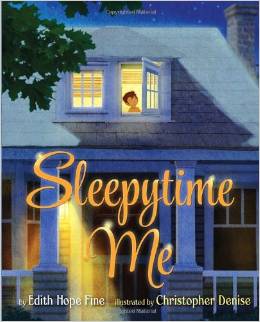 Well, okay, I can take a hint! And what do you know, a holiday weekend rolled around just in time for me to participate. So first: a big thank-you to all four of these generous friends, so eager to share the bloggity fun with me. Do click through on the links above to read their very interesting answers and find out more about their books. (Edith decided to sit out the hop herself, but you guys—I got a sneak preview of her new picture book, Sleepytime Me, illustrated by Christopher Denise, and it is a swooner. This year’s favorite bedtime reading, mark my words. It launches tomorrow! And I happen to know she’s got a companion workbook coming for her excellent Greek and Latin roots book, CryptoMania!, and it’s top-notch. Homeschoolers and teachers, you’re going to love it.)
Well, okay, I can take a hint! And what do you know, a holiday weekend rolled around just in time for me to participate. So first: a big thank-you to all four of these generous friends, so eager to share the bloggity fun with me. Do click through on the links above to read their very interesting answers and find out more about their books. (Edith decided to sit out the hop herself, but you guys—I got a sneak preview of her new picture book, Sleepytime Me, illustrated by Christopher Denise, and it is a swooner. This year’s favorite bedtime reading, mark my words. It launches tomorrow! And I happen to know she’s got a companion workbook coming for her excellent Greek and Latin roots book, CryptoMania!, and it’s top-notch. Homeschoolers and teachers, you’re going to love it.)
Okay, so here are the questions, which I actually feel pretty shy about answering. I hardly ever talk about my process.
• What are you working on?
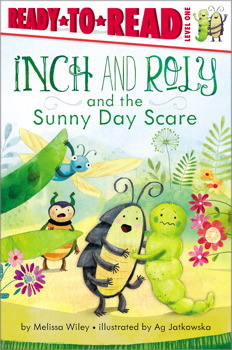 Generally, multiple things at once. The Main Project, always, and then two or three other works-in-various-stages-of-progress, and a scrawly list of ideas. Right now, the Main Project is the book I’ve been laboring over (very much in the childbirth-metaphor sense of the word) for a very. long. time: a historical fiction YA I’m writing for Knopf. It’s a project very close to my heart (involving a good bit of my own family history) and is probably the most challenging book I’ve written yet, in terms of research and subject matter. And I’ll want to talk lots more about it before too long.
Generally, multiple things at once. The Main Project, always, and then two or three other works-in-various-stages-of-progress, and a scrawly list of ideas. Right now, the Main Project is the book I’ve been laboring over (very much in the childbirth-metaphor sense of the word) for a very. long. time: a historical fiction YA I’m writing for Knopf. It’s a project very close to my heart (involving a good bit of my own family history) and is probably the most challenging book I’ve written yet, in terms of research and subject matter. And I’ll want to talk lots more about it before too long.
So that’s the front-burner book. Then there are the things I work on when that one is being obstreperous: I’m playing with a new Inch and Roly idea, now that Sunny Day Scare has packed its knapsack and gone off into the world to seek its fortune. (They grow up so fast!) And there’s a fantasy novel I play with when historical fiction is besting my brain.
And! And! Very very slowly, very very occasionally, I add a little to a memoir of sorts I’m writing (or thinking of writing, is probably more accurate) about our years in Astoria, New York, when Jane was going through chemotherapy. I have a lot of stories piled up from those days.
• How does your work differ from others in its genre?
That is a really good, and really hard, question. I feel like in a way it’s a question best answered by readers, not by me about my own work. I like to work with characters who are grappling with ethical dilemmas—Louisa struggling to find a way to clear her father’s name without revealing Angus’s secret and therefore exposing him to probably dangerous public scrutiny (The Prairie Thief); Martha wrecking her dustgown and getting away with it, but fessing up after an internal struggle (Little House in the Highlands). Kids trying to sort out right and wrong when the lines seem fuzzier to them than adults give the impression they are. I think in terms of my style itself, I may work differently (but who knows?) in that I’m hearing the work read aloud as I write—probably in part because read-alouds are such an enormous part of my life. I mean, I’m reading aloud all morning long; I’ve spent nearly nineteen years this way, days full of the written word spoken. I think that gets into your fingers, as a writer: the cadence and lilt of a good read-aloud, the distinct character voices, the aural underscoring the visual images created by the text. I think, too, my having studied as a poet comes into play here. I entered my MFA program as a poet and emerged as a writer of prose fiction, but you can’t get poetry out of your blood.
• Why do you write what you do?
I put this question to Scott, adding lamely that I write the stories I’m burning to write. “I don’t know how to nail it down more accurately than that.” He chuckled. He knows me better than I know myself. “Well, first,” he said, “there’s the pioneer thing—” and he’s right; he doesn’t mean just Pioneers of the American West, though certainly that period is a lifelong fascination of mine and my original concept for Prairie Thief jumped right out of Edwardian England, where I’d envisioned it taking place, and emigrated happily to the Colorado prairie, circa 1880. Scott, who knows what ideas are crammed into my mental Possibilities drawer, was speaking also of my love of all kinds of frontier stories—the Pern books, the Darkover novels, any kind of pushing forward to unknown terrain and making terms with it.
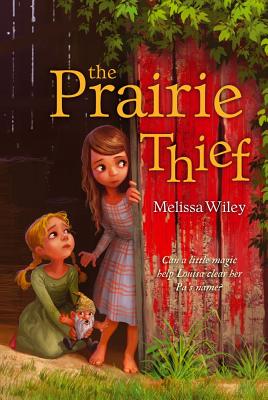 “But also,” he continued, “there’s your fascination with miscommunication and injustice. The injustice that arises when someone has been misunderstood. You’re always wanting to set that straight, in your work and in real life.”
“But also,” he continued, “there’s your fascination with miscommunication and injustice. The injustice that arises when someone has been misunderstood. You’re always wanting to set that straight, in your work and in real life.”
As soon as he said it, I could see it: this thread woven through so much of my work. It’s the central conflict of Prairie Thief, of course: a man falsely accused, his daughter intent on clearing his name. And other misunderstandings nested inside that larger one. But also: there’s Martha’s first governess, who doesn’t like her and misreads all her errors as deliberate. I had to bring in Miss Crow, didn’t I, to understand her. 🙂 Over and over in those books, there are miscommunications between family members that lead to conflict. Scott pointed out that Sunny Day Scare, too, plays with this theme: Inch and friends are interpreting a horror in the grass in different ways, and Roly simply has to figure out what the scary thing really is. Even Hanna’s Christmas, my little commercial tie-in from long ago, has Hanna’s parents incorrectly blaming her for all the acts of mischief around the house. This is kind of revelatory, actually, and you can bet I’m going to be pondering it further.
• How does your writing process work?
Ahh, a nuts-and-bolts question. Now I’m in my element. The way I work is married to time. When Jane was a baby and I was first starting out, I had to hurry and write during her naps, sometimes actually wearing her in the sling, though it was hard to type that way. After Rose was born and Scott left his job at DC Comics to stay home and write, I worked longer shifts, a couple of hours at a time. I had very tight deadlines in those deadlines, staggeringly tight as I look back, and had to work with furious efficiency in the spaces available to me. I probably work best that way.
Later still, after Beanie came along, Scott and I settled into a rhythm. My writing time was from 3-6 every day. So again, mega-focus required to stay on task. I started this blog as a way to help me do that: after a day with the kids, spending 20 minutes writing about them helped me transition from mom to writer, and then I could work on the book at hand.
We had a rough year after Wonderboy was born, but that same schedule allowed me to work. It was after Rilla came along that things changed dramatically: Scott took an editing job out here in San Diego, we moved, he was away long hours, I wrote on Saturdays. That’s why The Prairie Thief took so long: years of Saturday afternoons. In 2011, he came back home to freelance (hurrah!) and now I get the whole afternoon and evening to work—meaning both my fiction and my editorial gig at Damn Interesting.
I can’t stand writing by hand. I have complaining wrists. With the current novel, I began working in Scrivener and fell in love—it keeps all my notes, fragments, timelines, character sketches, and primary source material organized and accessible much more handily than any paper system I could contrive. I mean, I really think I’d be lost without it.
I’m a slow writer in that I self-edit ruthlessly, never having managed to do the sort of pour-it-out first drafts that the writing instruction books urge upon you. Dear Anne Lamott, I’ve tried, but I just can’t pull it off. And it’s too bad, because I always write way more than actually belongs in a book. I’ll labor over huge chunks of manuscript, polishing at the word-level, and then wind up ripping them out, a stitch at a time (agony) to hide in a file somewhere. If I were to gather up all my Martha fragments, I’d probably have enough for a whole nother book. (Sorry, it’s not in the cards.)
Every day, I dread starting. After I’ve made myself enter the cave, hours pass in a blink, like Narnia time.
I think I probably love the research stage best of all. I’m happiest with all my papers and books spread around me on the bed, and some old newspaper enlarged on my screen. An orchard robbery in 1817; the constable arrested “a man named Peter Twist and two well-dressed women.” What’s the story there? No one can tell me, so I’ll have to make it up.
Up next:
Now I’m supposed to tag some writer friends. Laurel Snyder (The Longest Night, Bigger than a Breadbox, Seven Stories Up) and Jennifer Ziegler (Sass and Serendipity, How Not to Be Popular, and the hot-off-the-presses Revenge of the Flower Girls—how’s that for a great title?? both said yes, so look for their replies in a week or so. I’m also tagging Chris Barton (Shark Vs. Train, The Day-Glo Brothers, Can I See Your ID?) and my dear friend Anne Marie Pace (Vampirina Ballerina, Vampirina Ballerina Hosts a Sleepover, A Teacher for Bear), in case they’d like to play along. But no pressure, guys! (See paragraph 1, above.)
And Sarah, Marcie, Edith, Tanita: thanks for tagging me. I had fun!
So I went to Alabama for research. I have volumes to tell about the trip—Scott says I could write a book about the writing of this book! I am working on a detailed account of the trip, but I will probably save most of it for when the book actually comes out. But for now, a few highlights.
We flew into Atlanta last Saturday night—or actually, it was early Sunday morning, I guess. Was nearly 2am by the time we reached our hotel. That’s only 11pm San Diego time, so it wasn’t too awful. On Sunday morning we met our friends Brian Stelfreeze and Stine Walsh for brunch at Ria’s Bluebird, which is now one of my Favorite Places to Eat, Ever.
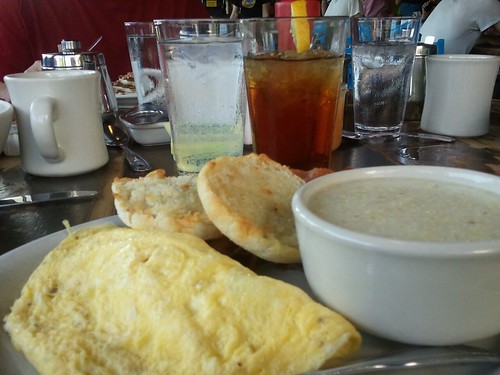
I could have eaten three bowls of those grits. The omelette was mushroom and fontina, if you’re like me and like to know as many details about people’s meals as possible. Also: homemade peach jam on those English muffins, and killer sweet tea.
We lingered long over our meal, and then lingered even longer in a baking parking lot talking to Brian and Stine, because we don’t get to see them that often and they are wonderful. I didn’t take any pictures! Unless you count my photo of a stinkbug on Brian’s shirt. What’s the matter with me?
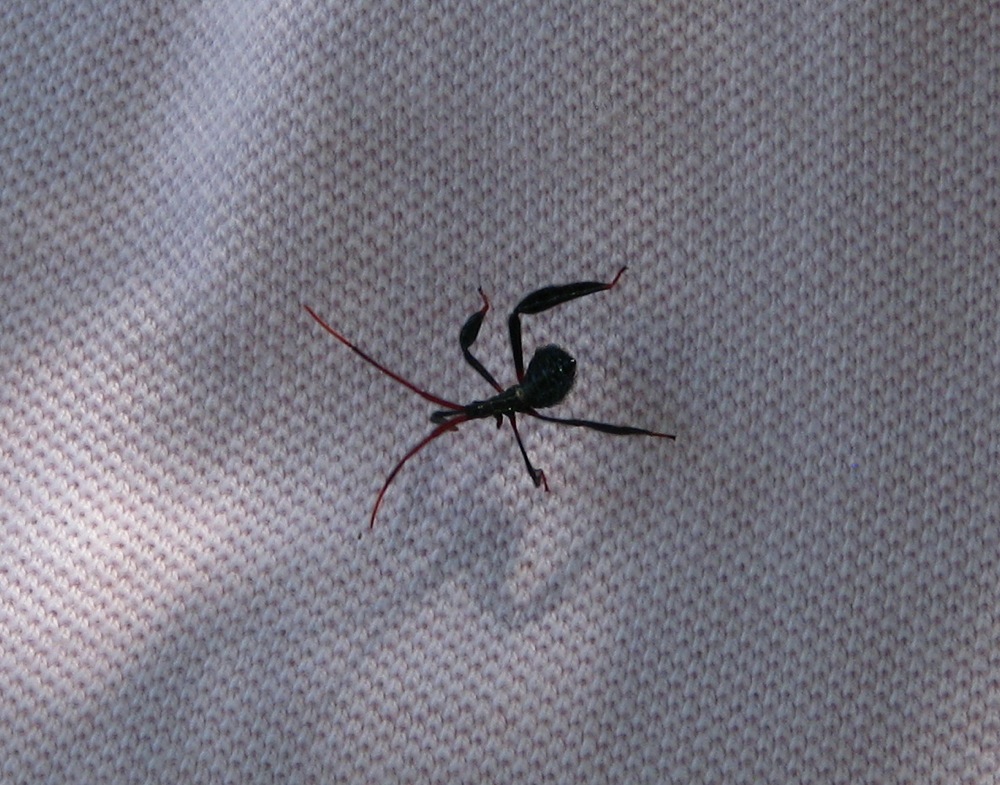
Eventually we dragged ourselves away and headed west. First stop: Hueytown, Alabama, just south of Birmingham to visit my Great-Aunt Cinderella and Great-Uncle Terrell. Yup, Cinderella is her real name—but you can call her Aunt Cindy.
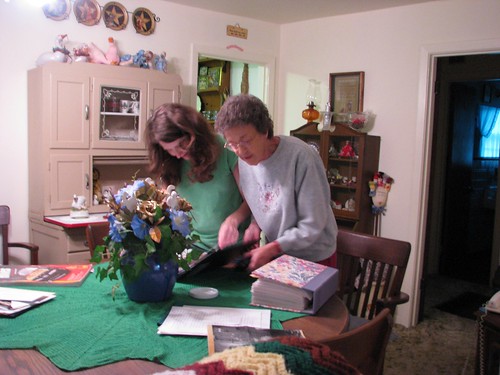
Aunt Cindy is my father’s aunt. Her older sister, Bettye, was the family genealogist and the person who first introduced me to the chapter of our family history that is the subject of my book. Aunt Cindy had her photo albums ready and waiting for me, and we spent several happy hours looking through them. She is a marvelous storyteller. This was to be a recurring delight on our trip—time with marvelous storytellers. I could have happily spent the whole week eating up Aunt Cindy’s stories. Uncle Terrell had some good ones of his own, too, but Scott had to tell them to me later because Aunt Cindy and I were talking a mile a minute.
All too soon we had to get back on the road. We wanted to reach our hotel before dark.
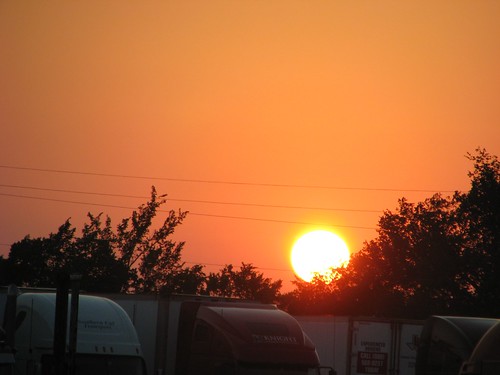
We stayed in [Small Town] but didn’t spend much time there. Our real destination was [I will tell you when I can]. First thing Monday morning, we drove to the County Archives in the heart of town. This county has a rich and unusual history in which my ancestors played a large part, and, well, that’s why I want to write about it, and I can’t wait until I can talk about it more openly. The incredibly nice folks at the Archives knew we were coming and were so kind to us all week, helping me look up information on old churches and schools and cemeteries and ancestors. And one day I will tell you all about where and what and who and why.

By an incredible stroke of luck, a distant relative of mine happened to be at the Archives when we first walked in. Of course, we didn’t know we were relatives right at first. I mentioned I was working on a certain branch of the family, and one of the archive volunteers said, “Oh, you need to talk to Darryal!” and motioned this kindly fellow over. He is a local historian and teller of fine tales, and one of the sweetest people you could ever hope to meet. Right away he offered to “carry us” to some cemeteries and other sites of relevance to my work. Not that morning—he was on his way to the funeral of his aunt who had died at the age of 105—but if we’d return the next morning, he’d be there.
Well. That was pretty exciting indeed. We spent the rest of Monday morning working in the Archives—my heroic husband spent at least an hour making photocopies for me—and then we moseyed down the street for a stunningly delicious meal at the local diner. (We liked it so much we ate there the next two days.) Best carrot cake I’ve ever had. (I liked it so much I ate it the next two days.)
After lunch we went out driving, exploring the area. Our wanderings took us through some of the tornado-ravaged towns I wrote about the other day. We also visited this old jail.
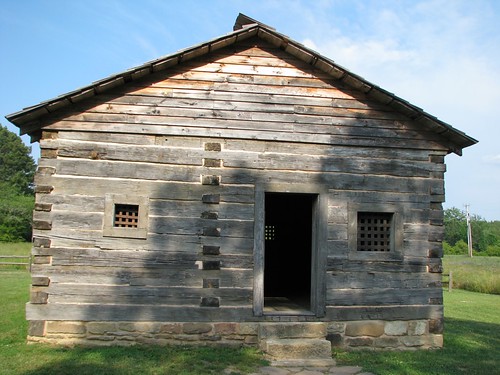
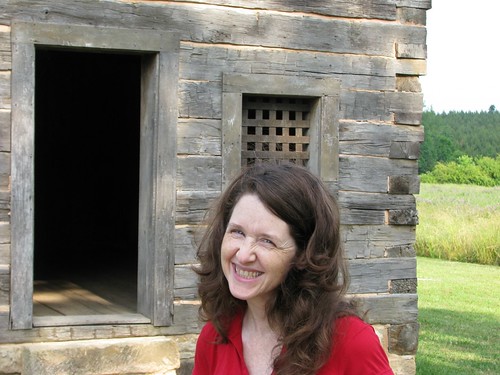
Bright and early Tuesday morning, we met up with Cousin Darryal (it’s pronounced Darrell) at the Archives. He climbed into our rental car and steered us toward the first of three cemeteries on our morning’s agenda. And this is where I could tell tons of stories, but I’m saving them for the book. Suffice it to say that Darryal is an expert on parts of the chapter of history I’m writing about, and we got along like gangbusters. He’s absolutely a kindred spirit—a real live Matthew Cuthbert. And he very generously gave us his entire day—amazing.
We quickly established our shared ancestry. His great-grandfather was the brother of my great-great-great-grandfather. The patriarch of one of the families I’m writing about is our mutual ancestor: Darryal’s 2nd-great, my 4th-great. (And also my 5th-great, due to a marriage of first cousins once removed a little on down the line).

The grave of one of the other brothers (there were nine of them altogether). Darryal is one of the people whose efforts keep these graves well tended and adorned with flowers.
It was kind of an emotional morning. These people I’ve been writing about, who have become so real to me, my great-great-greats and great-great-great-greats, there they were, their names on the stones. I’m kind of glossing over the real stories here, because I really do want to save them for the book. But it was quite something, seeing their graves and (later) walking on their land.
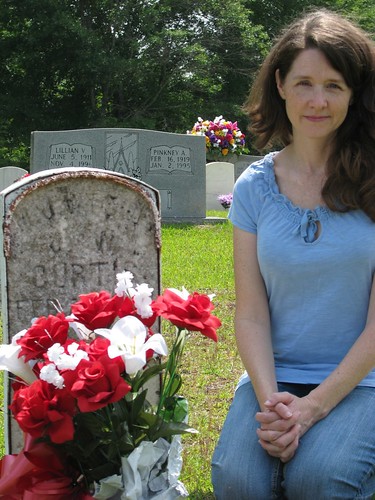
Darryal took us to see a creek bluff where one of my ancestors hid out for a while, and many other sites. And when I mentioned some of the other families I’m writing about, he said I needed to meet his buddy O’Neal, who—as it turns out—is ALSO my third cousin twice removed, but through an entirely different family line. He’s not kin to Darryal; they went to high school together. They both knew my father’s Aunt Bettye very well—“She was a dear friend to me,” said Darryal. “We dearly miss her.”
And so it came about that the next morning, we met Cousin Neal, and he took us on a tour of a whole different set of sites. We visited the cemetery where our mutual ancestor (again, his 2nd-great, my 4th-great) is buried, and then, O marvel of marvels!, he drove us right out to the spot where that ancestor homesteaded. I got to see where the house once stood, and we bumped down a steep branchy-slope-formerly-known-as-a-road to see the very spot in the river where the people in my book almost certainly swam and fished and swatted mosquitoes.
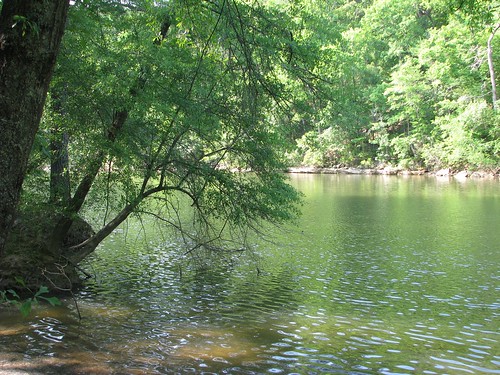
Cousin Neal is another born storyteller, with a deep and resonant voice, and a merry twinkle in his eye. He too gave us a full day of his time, even inviting us home to meet his wife Dot, where showed me some wonderful photos and even gave me some to keep. I could have stayed there a week, too.
Actually what I’d love to do is move my family there for the next year and write the novel in that beautiful hill country. I guess I’ll have to make do with going back someday—this time with the whole gang in tow, and my parents too. Perhaps when the book comes out.
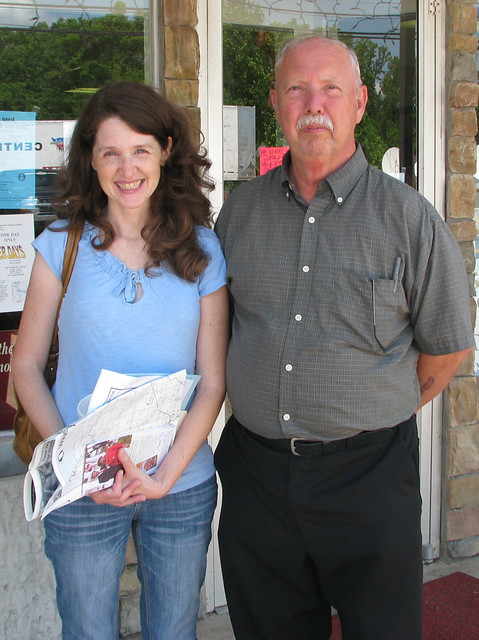
Cousin Darryal
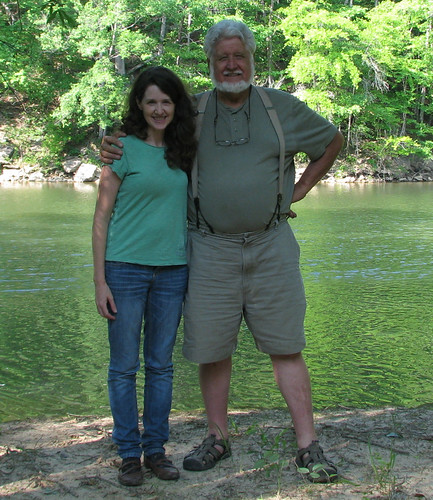
Cousin Neal
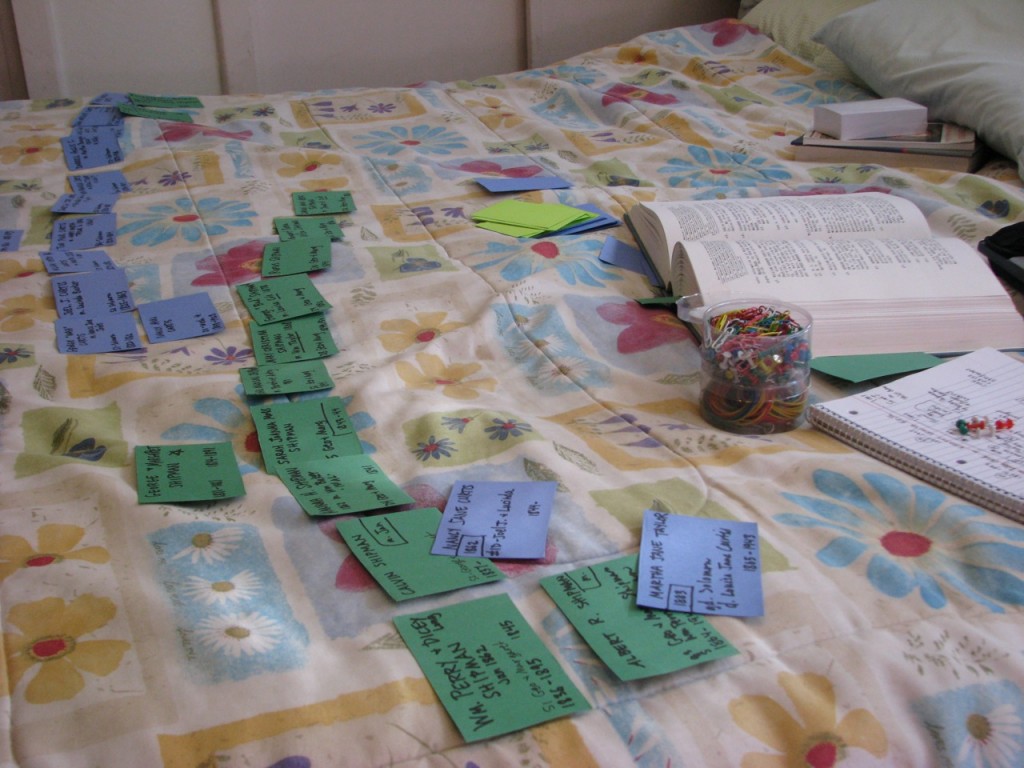




 Generally, multiple things at once. The Main Project, always, and then two or three other works-in-various-stages-of-progress, and a scrawly list of ideas. Right now, the Main Project is the book I’ve been laboring over (very much in the childbirth-metaphor sense of the word) for a very. long. time: a historical fiction YA I’m writing for Knopf. It’s a project very close to my heart (involving a good bit of my own family history) and is probably the most challenging book I’ve written yet, in terms of research and subject matter. And I’ll want to talk lots more about it before too long.
Generally, multiple things at once. The Main Project, always, and then two or three other works-in-various-stages-of-progress, and a scrawly list of ideas. Right now, the Main Project is the book I’ve been laboring over (very much in the childbirth-metaphor sense of the word) for a very. long. time: a historical fiction YA I’m writing for Knopf. It’s a project very close to my heart (involving a good bit of my own family history) and is probably the most challenging book I’ve written yet, in terms of research and subject matter. And I’ll want to talk lots more about it before too long. “But also,” he continued, “there’s your fascination with miscommunication and injustice. The injustice that arises when someone has been misunderstood. You’re always wanting to set that straight, in your work and in real life.”
“But also,” he continued, “there’s your fascination with miscommunication and injustice. The injustice that arises when someone has been misunderstood. You’re always wanting to set that straight, in your work and in real life.”











